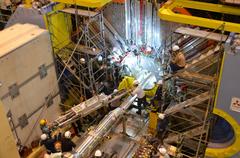URL: https://www.desy.de/news/news_search/index_eng.html
Breadcrumb Navigation
DESY News: The Beast is inside
News
News from the DESY research centre
The Beast is inside
A fairy-tale milestone: last weekend, scientists involved in the international Belle II collaboration at the Japanese research facility KEK installed a key component of the Belle II particle detector, which is currently under construction. This component goes by the name of “BEAST” and will spend several months measuring the radiation levels in the immediate vicinity of the interaction point, before being replaced by the new, highly sensitive vertex detector which is ultimately due to be installed in its place, probably in the autumn of 2018.

The scientists are using BEAST to carefully explore the possible effects of this huge increase in the collision rate on the vertex detector that will ultimately be used. “If the radiation levels are too high, this could destroy the sensitive vertex detector,” explains Carlos Marinas from the University of Bonn, who is in charge of putting the vertex detector into service.
The test detector BEAST, which is named in allusion to the fairy-tale “Beauty (=Belle) and the Beast”, contains only some of the components that will eventually be deployed. The BEAST’s sensor modules, which are used to determine positions to within a single pixel, only cover about one tenth of the entire solid angle. Also, BEAST contains additional instruments that will only be used during this test phase and that are particularly suitable for determining the precise composition of the radiation background. “This information can help accelerator physicists to understand how to get the most out of SuperKEKB, without damaging our sensitive detector in the process,” says Marinas.
The Belle II collaboration consists of some 750 scientists from 106 research institutes in 25 countries. Germany’s group, comprising research scientists from twelve institutions, is the second largest, after Japan’s, and has been responsible for designing and building the pixel vertex detector.
The Belle II detector is about ten metres high and ten metres wide and weighs around 1400 tonnes. Once data collection begins properly, its seven detector systems are meant to record the particles created during collisions between electrons and their antiparticles, known as positrons, as well as the decay of such particles.
Belle II is specialised, among other things, in the search for a difference that is small but at the same time crucial for our own existence: that between matter and antimatter. This difference is the reason why the universe consists almost exclusively of matter, despite the fact that equal amounts of matter and antimatter ought to have been created during the big bang. In their search for this difference, scientists are concentrating on so-called B mesons, particles containing either a b quark or a b antiquark. It is because of the b quark that the letter B plays such an important role in this area of research: Belle II will use the SuperKEKB accelerator, its predecessor Belle used the KEKB, and the LHCb experiment at CERN and BaBar at SLAC in the US, also have the letter B in their names.



